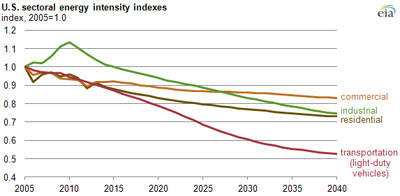Over the past few years, the International Energy Agency (IEA) has criticized countries for not investing enough in energy efficiency – the cheapest, quickest way to bring down greenhouse gas emissions and energy costs.
But now, for the first time, investments in efficiency are higher than those for renewable energy, and growing. In 2012, as much as $360 billion was invested worldwide in efficiency, compared to $213 billion for renewable energy (a low year).
Indeed, this "first fuel" is finally becoming an established market segment, with innovative new products and standards that are bringing stability and confidence to the market, says IEA.
Between 2001-2011, residential energy demand dropped the most – by 5%, largely due to increased efficiency. Over that period, 18 countries reduced energy use more than the amount consumed by the US and Germany combined in 2012.
Vehicle fuel economy standards now cover 70% of the global passenger light-duty vehicle market, saving $40-$190 billion in fuel costs and driving $80 billion in investment through 2020.
As much as 40% of the emission reductions needed to prevent global temperature rise beyond 2 degrees Celsius will come from energy efficiency, says IEA.
"If the world wants to avoid a temperature increase of 5 or 6 degrees Celsius by the end of the century, then ambitious programmes of energy efficiency have to be launched in all sectors and in all countries," says Executive Director, Maria van der Hoeven.
Financing for efficiency is expanding rapidly through green bonds, energy performance contracts, private commitments, carbon and climate finance, multilateral development banks and bilateral banks. Bilateral and multilateral lending alone amounted to more than $22 billion in 2012.
"Energy efficiency is moving from a niche interest to an established market segment with increasing interest from institutional lenders and investors," she says, but to "fully expand this market, initiatives to continue to reduce barriers will need to strengthen."
In the US
The US is using less energy each year because of great gains in the efficiency in appliances, products and vehicles. And that’s even with the trend for bigger homes and ownership of many more electronic gadgets.

Another $330 million in energy costs could be saved if those ubiquitous modems, routers, and other small network equipment were just 25% more efficient. They run 24/7, gobbling about $1 billion worth of electricity a year, according to Natural Resources Defense Council (NRDC).
"Small network devices suck roughly the same amount of energy around the clock, whether or not you are sending or receiving any data. But there are steps that manufacturers can – and should – take to make sure these devices are no longer energy vampires," says NRDC Senior Scientist Noah Horowitz.
There are 145 million of these devices in the US and one modem uses as much electricity as a new 32-inch flat screen TV. Cables boxes, however, are becoming more efficient.
Here’s how Americans are saving energy, according to a poll by Morning Consult Energy:
- 82% turn down the heat or air conditioning
- 79% buy efficient light bulbs
- 43% bicycle or walk to work
- 30% carpool and 29% take public transit
- 39% buy appliances based on energy ratings
- 27% have insulated their home
- 32% researched fuel efficient cars
Read the executive summary of IEA’s Energy Efficiency Market Report 2014:
